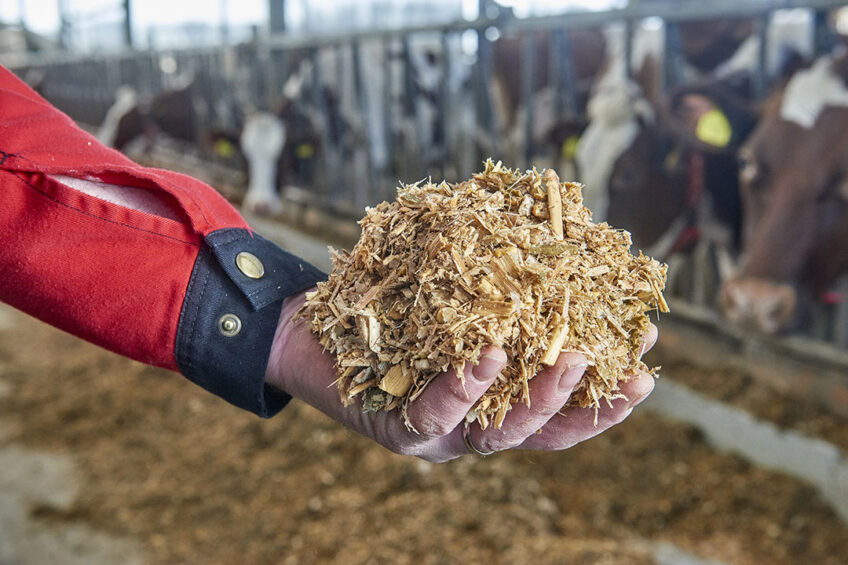Mycotoxins and animal performance

Mycotoxins can greatly affect health and productivity. There are a wide range of different mycotoxins, so a simple approach will not solve the problem. A combination of control measures are essential to reduce hazards.
The growth of moulds and hence the production of mycotoxins is determined primarily by environmental conditions and management factors.
Environment
These organisms require air, moisture, and a source of nutrients, including readily digestible carbohydrates. Some moulds, including those that produce mycotoxins, multiply far more rapidly with a warm temperature but others require a low temperature.
Damaged grains
Mycotoxins are much more troublesome when grains are damaged by drought, insects, or cracked during harvesting or handling, as the seed coat normally protects against mould invasion.
Silages
Silages that have too high a dry matter content are poorly sealed, not finely chopped, or not well packed, are much more likely to form mould and hence contain mycotoxins. Likewise, when the silage pH is not sufficiently low, mould is much more likely. During feeding, the silage will turn mouldy when left in the feed trough too long, depending on the temperature and other factors, including the pH. Silage near the feeding surface of a silo may turn mouldy if the feeding rate is too slow or if it is ‘“loosened” during feeding.
Effects on animal performance
Ruminants such as cattle, sheep, and goats are less known for their sensitivity to the negative effects of mycotoxins than non-ruminants. The performance of these animals can, however, be altered when consuming mycotoxin-contaminated feed for extended periods.
Impact on ruminants
In this case, there may be reduced feed efficiency due to reducing cellulose digestion, volatile fatty acid production, and rumen motility. There are also dramatic drops in milk production, weight loss, liver damage, and rumen metabolism. Bovine infertility and abortion in the final trimester of gestation have resulted from the consumption of feed contaminated – for example – with T-2 toxin. Calves consuming T-2 toxin at 10-50 mg per kg-1 of feed have demonstrated ulcers in the abomasum and sloughing of the papilla in the rumen.
Feeding diets contaminated with mycotoxins to ewe lambs at 2.5 or 5.0 mg/kg-1 of feed for 21 days resulted in symptoms of hepatic and nephritic lesions, altered mineral metabolism, and increased size and weight of the liver and kidney. Studies with other ruminant species such as goats revealed no such adverse effects even when a higher level of mycotoxins (95 mg/kg-1 of feed) is ingested.
Mycotoxins are also believed to induce immunosuppression in ruminants either by decreasing serum concentrations of IgM, IgG, and IgA, or by inhibiting DNA, RNA, and protein synthesis and impairing the synthesis of cytokines that regulate the communication network of the immune system. Mycotoxins also induce necrosis of lymphoid tissues that make up the lymphatic system, such as white blood cells (leukocytes), bone marrow, and the thymus, spleen, and lymph nodes, thus affecting the immune functions of these tissues.
Mycotoxins effect on vaccine response
Mycotoxins may further affect the response of animals to vaccines and other drugs. This effect was noted with chickens and turkeys, but not in ruminants. In one study, the responses of birds to vaccinations against diseases such as salmonellosis, coccidiosis, and infectious bursal diseases were dramatically reduced when receiving high levels of aflatoxins (from 0.2 to 1 mg/kg) in combination with other mycotoxins in poultry feed. Mycotoxins also reduced the anticoccidial efficacy of lasalocid in chickens. This effect was observed in the mortality rate and the percentage of birds developing lesions following an experimental challenge with Eimeria tenella or Eimeria mitis.
The economic impact of mycotoxins
There are multiple criteria for assessing the economic impact of mycotoxins on humans and animal agriculture. Considerations include loss of human and animal life, health and veterinary care costs, loss of livestock production, and loss of forage crops and feeds (over 1,000 million tonnes per year worldwide).
United States
Moneywise, it was estimated that the losses due to mycotoxins in maize in 8 south-eastern states of the USA amounted to US$97 million, with an additional $US100 million dollars in production losses at pig farms feeding on the contaminated maize.
India
In India, it was estimated that $US10 million were lost in India’s annual exports due to groundnut contamination with mycotoxins. In other parts of the world, random samples were taken from various crop farms, and it was determined that 30-70% of these samples were contaminated with mycotoxins such as aflatoxin B1; deoxynivalenol, and T-2 toxin but no monetary losses have been reported.
4 control measures
1. Agricultural practices
Early harvesting: Early harvesting reduces fungal infection of crops in the field before harvest and consequent contamination of harvested produce. It was reported that early harvesting and threshing of groundnuts resulted in lower aflatoxin levels and higher gross returns of 27% compared to delayed harvesting.
Proper drying: Rapid drying of agricultural products to low moisture levels is critical as it creates less favourable conditions for fungal growth and proliferation and insect infestation. In West Africa farmers focused on thorough drying and proper storage of groundnuts in subsistence farm villages and achieved a 60% reduction in mean aflatoxin levels in intervention villages.
Insect management: Insects carry spores of mycotoxins producing fungi from plant surfaces to the interior of the stalk or kernels or create infection wounds through their feeding habits. Therefore, proper management of insect pests through any appropriate control strategy is likely to reduce the mycotoxin contamination problem.
2. Physical methods
Physical strategies including thermal processing (cooking, boiling, baking, frying, roasting, microwave heating, extrusion) and irradiation were applied to inactivate the toxin or to reduce its content in foods and feeds.
3. Chemical methods
A variety of chemicals, including acids, bases, oxidising reagents, reducing agents, chlorinating agents, and miscellaneous reagents were tested to detoxify mycotoxins. The success of the detoxification process due to chemical treatments strongly depends on the type of food and/or feed. The use of chemicals in combination with physical treatments such as thermal processing for the detoxification of food products contaminated with mycotoxins increased the efficacy of mycotoxins degradation.
4. Mycotoxin-binding agents
The addition of nutritionally inert sorbents such as hydrated sodium calcium aluminosilicate (HSCAS), zeolites, bentonites, clays, and activated carbons.is one of the most recent approaches to reduce mycotoxin toxicity in animals and carryover of mycotoxins from contaminated feeds to animal products (milk, meat, and eggs). Sorbents act by reducing the bioavailability of mycotoxins by adsorption on their surface. Indeed, if a stable sorbent-mycotoxin complex is formed, the absorption of mycotoxins in the gastrointestinal tract can be reduced, decreasing both toxic effects for the animal and carryover in animal products for human consumption.
References are available upon request.











